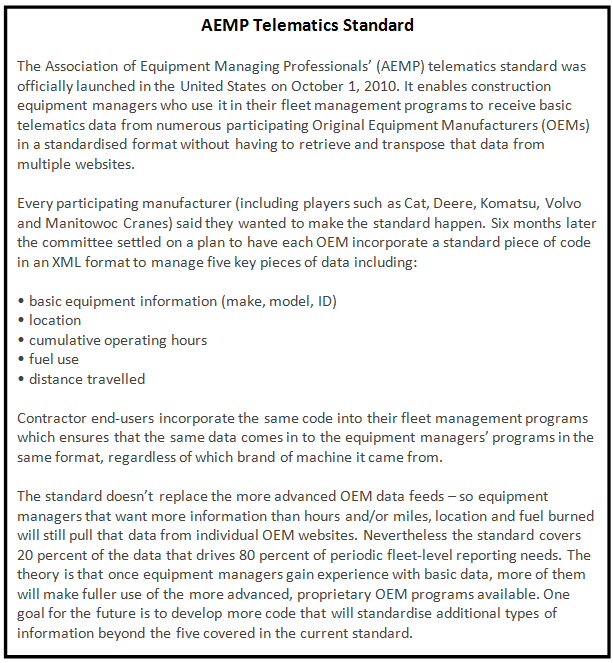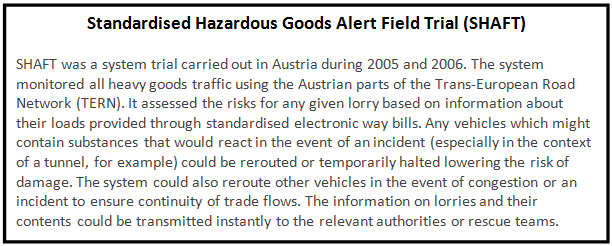
Road Network Operations
& Intelligent Transport Systems
A guide for practitioners!

Road Network Operations
& Intelligent Transport Systems
A guide for practitioners!
The gathering of data about how vehicles are being used is a valuable resource for many firms. Data can be captured from three major sources: vehicle sensors, driver behaviour and goods’ condition sensors. These are relevant to vehicle and driver safety and multi-level security systems. (See Vehicle Safety, Driver Safety and Security)
The ability to track the location of vehicles is one of the main basic functions of all Fleet Management systems. It is usually based on the use of GPS to plot the location of the vehicle in real-time, although it can based on a cellular triangulation system. There are two main types of system used in modern devices:
The collection of data on the condition of the vehicle, such as road speed, engine RPMs, coolant temperature and tyre pressures (for example) have proved very useful for:
However for operators with fleets composed of vehicles from multiple manufacturers the non-standardised way in which vehicle sensor information is recorded and stored can be problematic because of data incompatibilities between different proprietary systems and the difficulties of integrating the information to manage the fleet as a whole most effectively.

Data on driver behaviour makes it possible to develop a profile of driving behaviour for any given driver. This can often be supported by real-time video monitoring with cameras inside and outside the vehicle, enabling the driver and the surrounding traffic to be monitored. The information captured can assist in the creation of training programmes for specific drivers to target areas most in need of improvement and it can help in accident investigation.
Where the data is integrated into driver feedback and training, changes in driving behaviour can deliver large-scale savings for fleet operators. For example, one such product “GreenRoad” (www.greenroad.com) claims changes in the scale of:
These are often the main cost drivers in the freight and commercial vehicle industry, so any savings can be significant in lowering costs and winning new business. Although products may differ between manufacturers, the technology is the broadly similar. An on-board unit senses how the vehicle is being driven, the vehicles’ location and other useful data – which can be stored and relayed in real-time (usually via satellite or mobile phone technology) to both the driver and a central monitoring location.
Sensors within the vehicle offer the opportunity to monitor the status of the goods being transported. This has proven particularly useful in the fresh and frozen produce and chemical industries where ensuring that temperatures have been maintained at a specific level can be of vital importance in the acceptance of goods. Other sensors can detect whether or not goods have been tampered with by sensing whether they are accessed in transit. (See Security)
Authorities have a particular interest in tracking HGV movements across national road networks, especially with regard to dangerous or hazardous loads.

The modularity of on-board monitoring and telematics systems, with the capability for adding sensors, allows for easy customisation of features. This means that only the most relevant features need be bought and installed for any given vehicle or firm. This is important given that the systems can be very expensive. Prior to installing widespread telematics and on-board monitoring systems, it is worth remembering that the sensors are only as useful as the action that is taken in response to them. It is how the data that is recorded is interpreted and used by operators to manage their fleets - that makes the real difference. Driver behaviour monitoring is redundant unless the results are closely monitored and appropriate training provided to solve the issues presented. Likewise, knowledge of the condition of a vehicle is useful only when acted upon with preventative maintenance.
Given the expense of such systems, two questions need to be asked before they are used:
This is a developing area - and the expensive installation of sensors can sometimes be avoided. Increasingly the use of smartphones is seen as an alternative approach. Several applications can measure, through accelerometers and internal gyroscopes, driver behaviour and these should be assessed first as a low-cost trial solution.